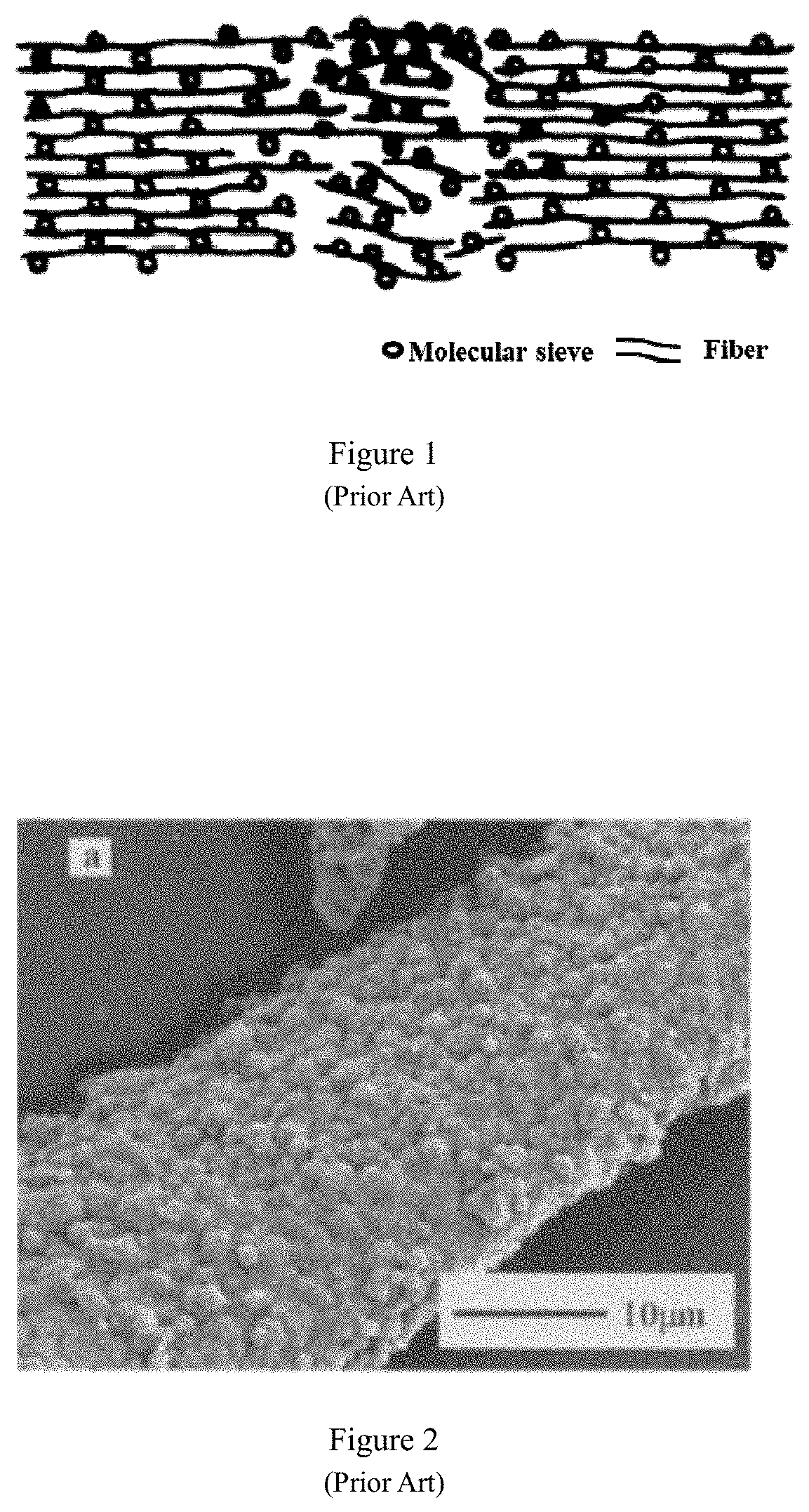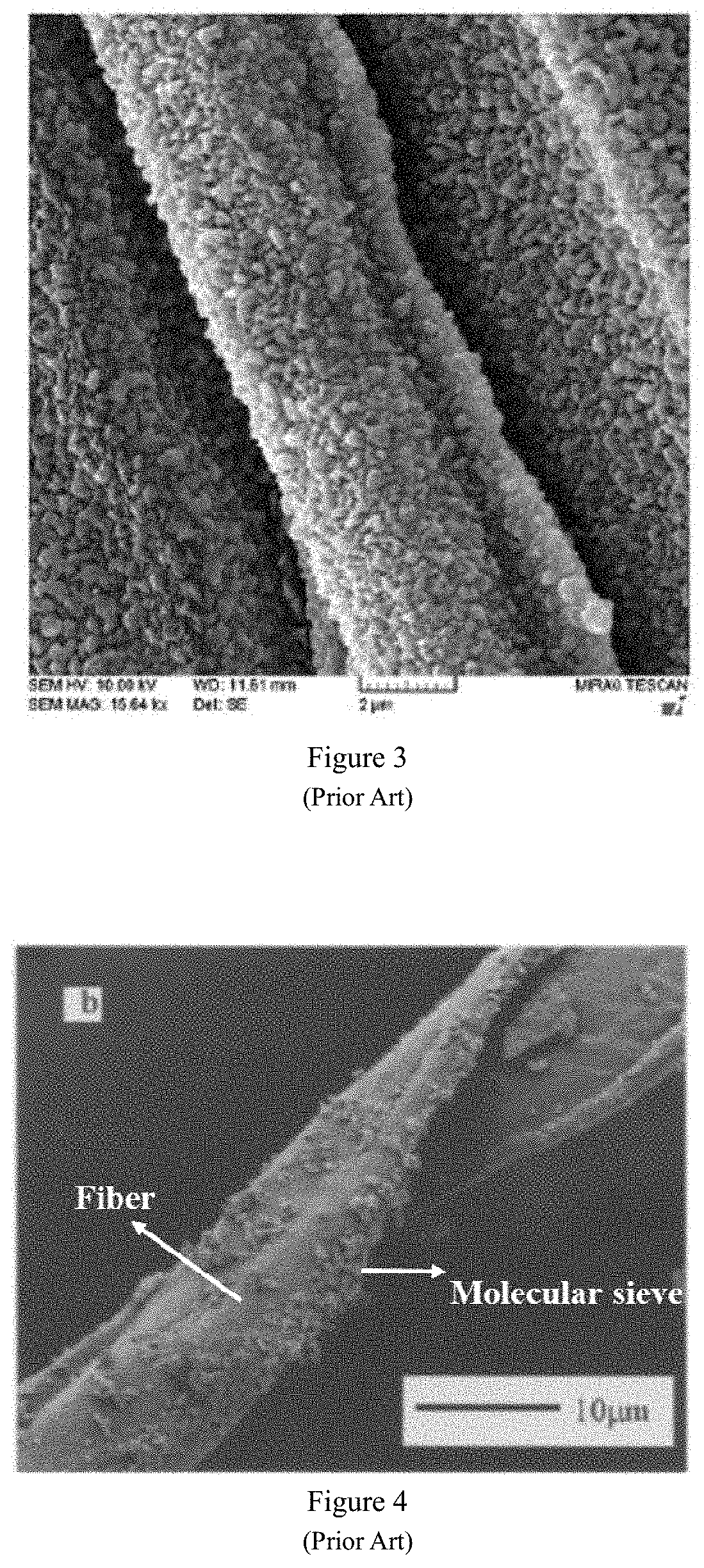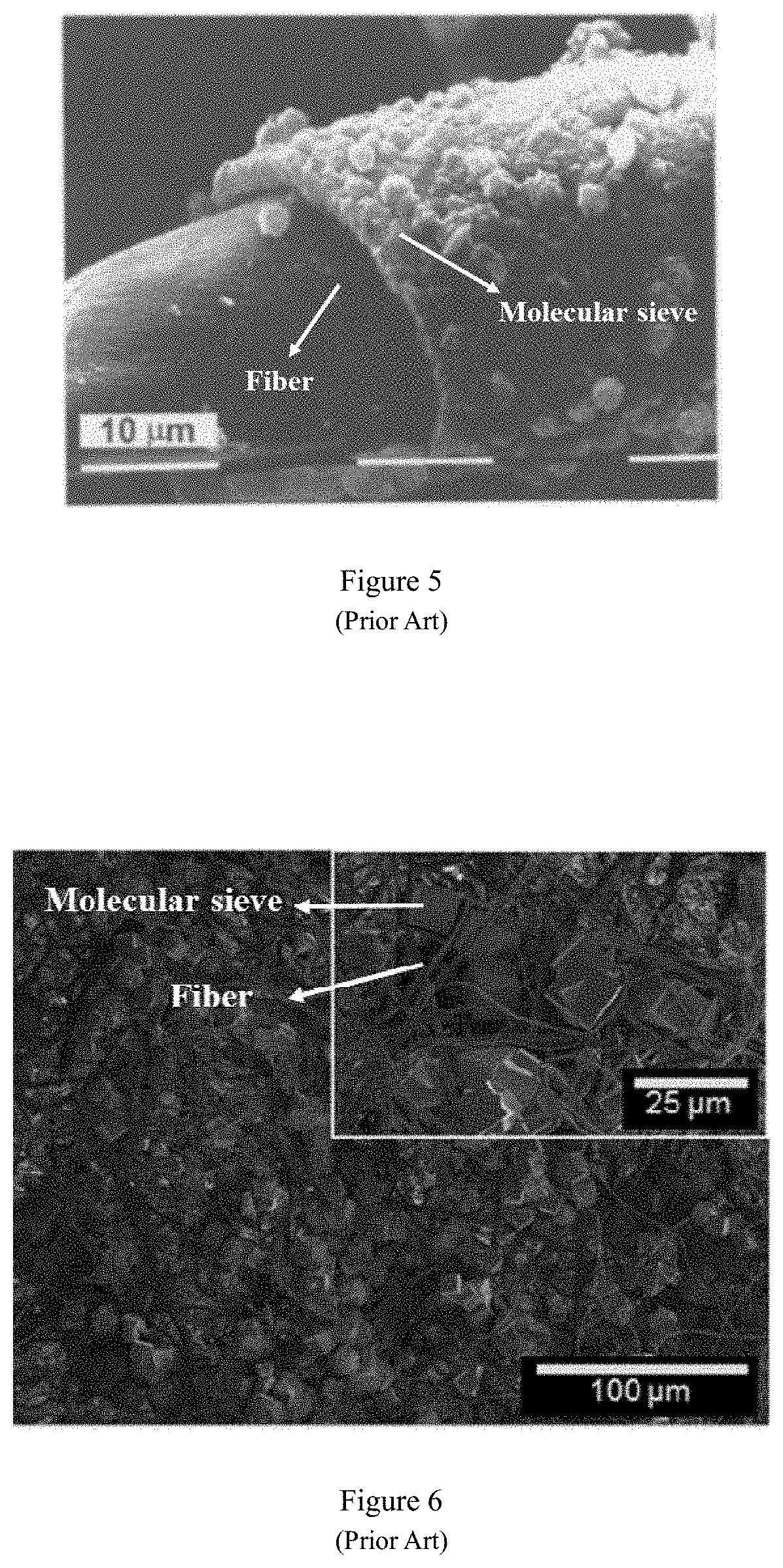However, inorganic fibers are brittle, easy to break, and easy to wear, which makes them unsuitable as a flexible carrier for molecular sieves.
(1) Pretreatment of the fibers. The pretreatment refers to a treatment method that destroys the
fiber structure. In the prior art, in order to enable the molecular sieve to be directly bonded to the fiber, the fiber must be pretreated first. Pretreatment methods mainly include
chemical treatment, mechanical treatment, ultrasonic treatment,
microwave treatment, and so on. The method of
chemical treatment is divided into treatment with a base compound, an acid compound, an
organic solvent, etc. The base compound may be selected from any one or more of NaOH, KOH, Na2SiO3, etc. The acid compound may be selected from any one or more of
hydrochloric acid,
sulfuric acid,
nitric acid, etc. The
organic solvent may be selected from any one or more of
ether,
acetone,
ethanol etc. Mechanical treatment can be by crushing or
grinding fibers. The above-mentioned fiber treatment methods, although the pretreatment to a certain extent activates the polar groups (such as hydroxyl group) on the fiber surface, but seriously damages the structure of the fiber (FIG. 1), destroying the fiber flexibility, elasticity and other characteristics. The fiber becomes brittle, hard and other bad phenomena, and cannot give full play to the advantages of fiber as a carrier. In addition, pretreatment of the fibers will cause molecular sieves to aggregate on the fiber surface. For example, molecular sieves are wrapped on the fiber surface with agglomerates or massive structures (FIGS. 2 and 3), resulting in poor fiber flexibility of fiber; or molecular sieves are partially agglomerated and unevenly distributed on the fiber surface (FIG. 4); or there is a gap between the fiber and the molecular sieve (FIG. 5), and the force between the molecular sieve and the fiber is weak. The aggregation of molecular sieves on the fiber surface will lead to uneven distribution of molecular sieves on the fiber surface, and cause differences in the properties across molecular sieve / fiber composite material, reducing the original specific surface area of the molecular sieve, leading to blockage of the molecular sieve channels and lowering the ability of
ion exchange and pore material exchange. The pretreatment of the fiber surface is at the cost of destroying the
fiber structure. Although the interaction force between the part of fiber and the molecular sieve is enhanced to form a molecular sieve / fiber composite to a certain extent, the interaction force is still not strong enough. Under external conditions, for example, a simple washing method will also cause a large number (50-60%) of molecular sieves to fall off the fiber surface (Microporous & Mesoporous Materials, 2002, 55 (1): 93-101 and US20040028900A1).
(2)
Adhesive bonding. In order to increase the
bonding strength between the molecular sieve and the fiber, the prior art mainly uses the
adhesive to interact with the molecular sieve and the fiber to form a sandwich-like structure, and the middle layer is the
adhesive, so that the molecular sieve can be indirectly bonded through the
adhesive on the fiber (FIG. 18).
Adhesive is a substance with a stickiness that relies on a
chemical reaction or physical action as a medium to connect the separated molecular sieve and the fiber material together through a binder. For adhesives, the main disadvantages include: (1) the quality of the joint cannot be inspected with the
naked eye; (2) careful surface treatment of the adherend is required, such as
chemical corrosion methods; (3) long
curing time is needed; (4) the temperature used is too low, and the upper
temperature limit for general adhesives is about 177° C., and the upper
temperature limit for special adhesives is about 371° C.; (5) most adhesives require strict
process control, and especially the cleanliness of the bonding surface is higher; (6) the service life of the bonding joint depends on the environment, such as
humidity, temperature, ventilation and so on. In order to ensure that the performance of the adhesive is basically unchanged within the specified period, strict attention must be paid to the method of storing the adhesive. For molecular sieves, the main disadvantages of using adhesive include: (i) uneven distribution of molecular sieves on the fiber surface; (ii) easy agglomeration of molecular sieves, reducing the
effective surface area of molecular sieves, and possibly causing blockage of molecular sieve channels, and reducing
ion exchange of molecular sieves, and leading to poor transfer of materials and high cost of synthetic molecular sieves. In addition, the addition of the adhesive does not significantly increase the load of the molecular sieve on the fiber; does not greatly enhance the binding of the molecular sieve to the fiber. And the molecular sieves still easily fall off the fiber surface. From a microscopic perspective, through
scanning electron microscope observation, the “molecular sieve / fiber composite material” referred to in the prior art has not been observed to have a distinct bonding interface between the molecular sieve and the fiber, indicating that the bonding between the molecular sieve and the fiber through the adhesive in the prior art is not firm.
The agglomeration of molecular sieve particles will reduce the
effective surface area of the molecular sieve and the ability of material exchange.
The molecular sieve is unevenly distributed on the fiber surface, which is difficult to achieve equal content of molecular sieve on fiber surface.
Although molecular sieves can be attached to the surface of
plant fibers by covalent bonds of the binder, the amount of adhesion is limited (all below 5 wt %).
Although the adhesive strength of the fiber and molecular sieve is increased to some extent under this condition, it still falls off under ultrasonic conditions.
For this composite material, both the surface of the molecular sieve and the fiber interact with the binder, and the sandwich-like material is formed by the adhesive of the intermediate layer, which increases the cost of the synthesis process and reduces the
effective surface area of the molecular sieve.
The four structural forms of the composite material have poor dispersibility of the molecular sieve and a small effective specific surface area, so they cannot exert their performance well.
Among the first three structural forms of the composite materials, the molecular sieves have a
weak binding strength with the fiber, and the molecular sieves may easily fall off the fiber surface.
Without the addition of an adhesive, the prior art cannot achieve uniform distribution of molecular sieves that directly contact the fiber surface, cannot achieve a
strong binding between the molecular sieves and the fibers of molecular sieve / fiber composite material, and cannot not remain the original large effective specific area and strong pore material exchange capacity of molecular sieves on the fibers.
Due to their small pores (usually 0.4 to 1.2 nm), the molecular sieves severely affect the transport of substances for their internal active sites, which extremely limits their performance as catalysts for macromolecular reactions (catalytic
cracking, etc.).
(1) Post-treatment method of microporous molecular sieve (e.g. high-temperature heat treatment, high-temperature
water vapor treatment,
acid treatment, alkali treatment of microporous molecular sieve, etc.). Through the treatment, aluminum or
silicon can be selectively removed from the framework, and secondary pores are generated in the formed molecular sieves. However, the framework of molecular sieve is easy to collapse during post-
processing of dealumination or desiliconization. In addition, the
connectivity between mesoporous channels is not good, and the
diffusion and transmission of macromolecules is not improved. Besides, a large amount of waste liquid is generated during the synthesis process, which not only pollutes the environment but also wastes reagents, so this method is greatly limited in practical applications.
(2) Template method (soft template method and hard template method).
Although the soft template method can synthesize mesoporous molecular sieves, the soft template is generally expensive and requires strict experimental conditions.
Therefore, this method generally cannot meet the requirements of industrial production.
The templating agents that can be used in the hard template method have large limitations in terms of type or shape.
Especially after the hard templating agent is removed, the
connectivity of the obtained mesoporous channels is relatively poor, which limits practical application of molecular sieves.
In summary, the methods of synthesizing mesoporous molecular sieves still have disadvantages in the prior art: (1) The mesoporous molecular sieves synthesized by the template method (including the hard template method and the soft template method) will affect the pore channel
connectivity of molecular sieves and limit the
catalysis on the surface of molecular sieves and other applications in the presence of the templating agents.
(2) Mesoporous molecular sieves prepared by the hard template method generally have poor connectivity of the mesoporous structure, while the soft template method is relatively expensive, which limits the application of the template method to a certain extent.
However, this method is easy to cause the collapse of molecular sieve framework, poor
controllability of secondary pores, and environmental
pollution.
Therefore, the synthesis of mesoporous molecular sieves in the prior art is complicated and time-consuming, and the molecular sieves cannot achieve the expected catalytic performance, and organic templating agents have great environmental
pollution.
Humans (including animals) can be injured in a variety of situations.
If such assistance is not readily available, excessive
blood loss may result in death.
Bleeding is a very serious global problem.
In the prior art, molecular sieves mainly cover wounds in the form of granules or
powder to stop bleeding, and the wounded may feel uncomfortable.
Because the hemostatic materials need to completely cover the wound,
powder and granular molecular sieves are used as hemostatic materials in very large amounts, which causes the molecular sieves to absorb a large amount of water and exotherm on the wound and easily burn the wound.
During use, the molecular sieves will stick to the wound, which is very difficult to clean.
It needs multiple flushes to remove them, which easily leads to secondary bleeding.
The granular molecular sieves need to be adhered by an adhesive so that the molecular sieves cannot contact the blood of the wound sufficiently, which affects the hemostatic effect of molecular sieve.
The composite materials of these four structural forms have poor dispersibility and small effective specific surface area of the molecular sieves, insufficient contact with blood during use, and poor hemostatic effect.
Molecular sieves tend to remain in blood vessels, inducing the risk of
thrombosis.
The composite materials formed by inorganic hemostatic materials and fibers also have the above-mentioned four defective structural forms, which seriously affect the performance and safety of hemostatic materials.
However, the adhesive not only reduces the contact area of the clay material with the blood, but also has a
weak binding strength between the clay material and the gauze fibers.
This defective structural form limits the hemostatic properties of the hemostatic product and risks causing sequelae or other side effects (such as
thrombus).
A large part of the inorganic
hemostatic powder in the hemostatic spandex fiber is inside the fiber, which cannot fully contact with the blood and cannot exert its hemostatic effect.
Although the amount of inorganic
hemostatic powder is increased, the hemostatic effect is not good.
The problems with hemostatic materials in the prior art are: (1)
powder and granular molecular sieves (or inorganic hemostatic materials) absorb a large amount of water and release heat on the wound; (2) the composite materials formed from molecular sieves (or inorganic hemostatic materials) and fiber have poor dispersibility and small effective specific surface area of molecular sieves, and represent insufficient contact with blood during use and poor hemostatic performance; (3) the binding strength between molecular sieve (or inorganic hemostatic material) and fiber is weak, and molecular sieves are easy to fall off from the fiber surface during practical use.
The
retention rate of molecular sieves is low, and the hemostatic material easily loses the hemostatic effect.
Without the addition of an adhesive, the prior art cannot achieve a
strong binding between the molecular sieve (or inorganic hemostatic material) and the fiber, cannot prevent molecular sieve fall off, cannot achieve good dispersibility of molecular sieve on the fiber surface, and cannot remain effective specific surface area of molecular sieve and cannot possess excellent
hemostatic function of molecular sieve and fiber composite.
 Login to View More
Login to View More 


